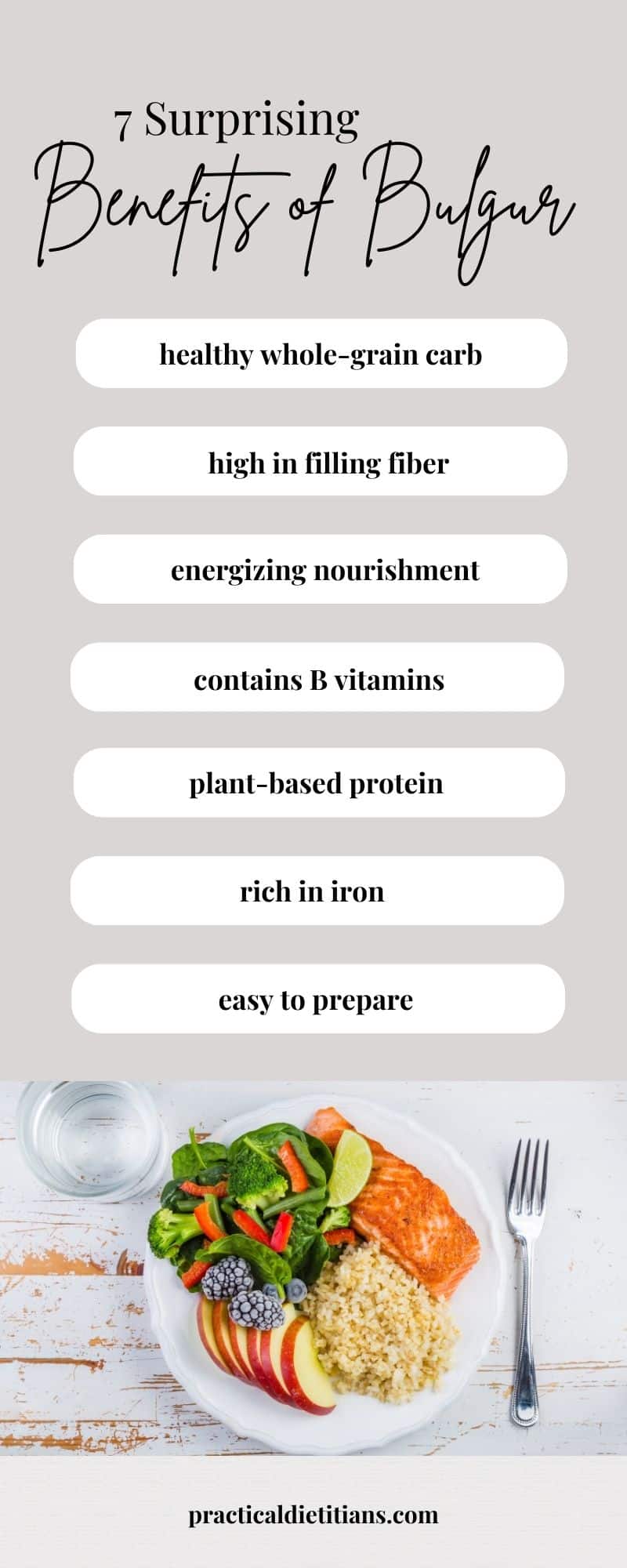Cracked wheat is a whole-grain kernel that has been broken into several ranges of coarseness. Because the kernel remains intact, it is a whole grain.
Keeping the entire grain kernel means that it still contains its naturally occurring bran, which is rich in fiber; germ, which contains vitamins and healthy fat; and starchy endosperm. The combination of the three (bran, germ, and endosperm) makes it a healthy carb for women.
Cracked whole wheat vs bulgur
Bulgur is made from cracked whole wheat that has been precooked. This process shortens the final preparation time, making it convenient for the consumer.
If you don’t know what bulgur is, that’s ok. A simple explanation is that it’s a whole-grain cereal from wheat. You may have eaten it in tabouleh or other Mediterranean dishes. It may sound weird because you are unfamiliar with it, but it’s simple to prepare and offers a mild flavor that can be enjoyed with many meals.

How cracked wheat can benefit women
Whole grains like bulgur are delicious, energizing, and satisfying healthy carbs that give us filling fiber that can help prevent constipation and lower your blood cholesterol. Whole grains also help manage blood sugar.
Cracked wheat or bulgur furnishes bone and muscle-strengthening protein to support your skeleton. They also provide a range of B vitamins to help your body process the energy from the foods you eat.
Bulgur contains more fiber than quinoa, oats, millet, buckwheat, or corn. Including whole foods that offer fiber helps keep your digestive system working at its best.
Nutrients in bulgur (half-cup cooked) for women 51 and older.
- Thiamine 0.052 mg, 5% RDA
- Riboflavin 0.026 mg, 2% RDA
- Niacin 0.91 mg, 7% RDA
- Pantothenic Acid 0.313 mg, 6% RDA
- Pyridoxine 0.075 mg, 5% RDA
- Folate 16.4 mcg, 4% RDA
- Iron 0.9 mg, 11% RDA
- Magnesium 29 mg, 9% RDA
- Protein 3 g
- Carbs 17 g
- Fiber 4 g
Using bulgur in the kitchen
We use it as a side dish to another staple, such as pan-seared fish with a drizzle of olive oil and lime. If the fish isn’t defrosted, you can mix it with canned beans. To round out the meal, add microwaved veggies and seasonal fruit.
To cook bulgur, just bring two parts water and one part bulgur to a boil, then cover and let it simmer for 12 minutes for the bulgur to absorb the water. In the meantime, microwave your choice of veggies. Steam veggie bags without added sauce or seasonings work great. You can also use a microwave-safe dish if your veggies are not in a microwave steamer bag.
Is bulgur healthier than rice?
Nutrients in brown rice (half-cup cooked) for women 51 and older.
- Thiamine 0.18 mg, 16% RDA
- Riboflavin 0.069 mg, 6% RDA
- Niacin 2.585 mg, 18% RDA
- Pantothenic Acid 0.38 mg, 8% RDA
- Pyridoxine 0.124 mg, 8% RDA
- Folate 9 mcg, 2% RDA
- Iron 0.565 mg, 7% RDA
- Magnesium 39.4 mg, 12% RDA
- Protein 3 g
- Carbs 26 g
- Fiber 2 g
Bulgur does contain more fiber and iron than brown rice; however, brown rice is a major contributor of B vitamins.
Conclusion
Cracked wheat is a minimally processed whole grain that is beneficial to women. Bulgur is cracked wheat that has been further processed by cooking and drying to make it a convenient, healthy carb for the home cook. Enjoy this easy prep grain as a nutrient and fiber-filled mildly tasting side dish.
For more information on healthy carbs, click here to get your Companion Tools for healthy living.


